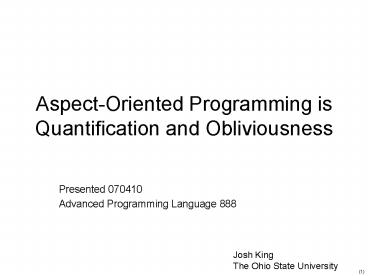AspectOriented Programming is Quantification and Obliviousness - PowerPoint PPT Presentation
1 / 15
Title:
AspectOriented Programming is Quantification and Obliviousness
Description:
Need a cooperative programmer for child classes ... System should not rely on programmer's compliance with a contract to be correct ... – PowerPoint PPT presentation
Number of Views:34
Avg rating:3.0/5.0
Title: AspectOriented Programming is Quantification and Obliviousness
1
Aspect-Oriented Programming is Quantification and
Obliviousness
- Presented 070410
- Advanced Programming Language 888
Josh King The Ohio State University
2
The report
- Robert Filman and Daniel Friedman
- NASA technical report
- Workshop on Advanced Separation of Concerns,
OOPSLA 2000 - What prompted their paper
- Is event based publish and subscribe (EBPS) AOP?
- (prompted by question from Tzilla Elrad)
- Message of the report The two properties
quantification and obliviousness are necessary
for AOP
3
Caveat lector
Arent saying AOP is the end-all be-all Theyre
saying the way AOP should be.
4
Earlier models
- First programming languages
- A statement is
- unitary (exactly once)
- local
procedures
locality broken
inheritance
5
Quantification
- Need quantification when there are statements
that have effect on many loci in the underlying
code - Quantification the specification of where these
loci are
6
Tiny example
- Traffic movement simulation program
- Want to add display aspect
- Quantification whenever something moves, the
screen must be updated - Where to put the display call
- Could use send-super approach
- Need a cooperative programmer for child classes
- What if a programmer forgets to abide by the
contract - Programmers are not always cooperative
- Cooperation is not good enough
7
Obliviousness
- System should not rely on programmers compliance
with a contract to be correct - mixin inheritance
- code of derived class is assembled with code of
the advising super class - derived class is unaware of super class and
whatever concerns the super class takes care of - This means dont need a contract with the
programmer.
8
AOP, in general
This breaks with local and unitary demands
9
Quantification Types
- Static structure
- Black Box (simple to implement wrapping)
- advise by interface
- Clear Box (harder to implement compiler)
- good for debugging
- Dynamic behavior
- advice quantified by runtime status of program
- exceptions
- calling a certain procedure from a certain other
method - patterns on the history of program execution
- their example after the try password routine
fails five times - abstractions of quantification depend on
underlying language
can you wrap an access to a public variable?
10
Other dimensions
- Context
- how much of P should A be able to reference
- Quantification scope
- upon what elements in P can be conditioned
- Dynamic quantification
- dynamically changing the set of actions /
conditions - Incomplete obliviousness
- e.g. Application needs to set tasks priority
- Action interaction
- two actions needing to talk to each other
- Relative aspect orderings
- two actions applying to the same location
- Inconsistent aspects
- two actions that violate each others semantics
need a way to detect and prevent - Weaving
- how to weave? compile time / run time
11
Possible AO languages
- Tzillas question Whats an aspect-oriented
language - Rule based systems
- e.g., Prolog purely dynamically quantified
statements - the idea that other things going on besides the
main flow isnt the least bit strange - but hard to program
- sequential nature destroyed
- classical AOP augment conventional sequential
statements with quantifications - Event based, publish and subscribe
- Quantification is apparent
- Is EBPS oblivious?
- depends on applications programming style
- events as interface between components vs.
introducing a contract that programmers publish
events - Intentional Programming and Meta Programming
- direct execution order in arbitrarily defined
computational patterns - environments for writing compilers, rather than a
realization of the AOP idea - Generative Programming
- transforming higher-level representations of
programs into lower-level ones - creator of a GP system may internally aspects
deemed important
12
Their closing remarks
- AOP is not about OOP
- AO can be done w/o OO
- pleasant environment vs. necessary one
- AOP is not useful for singletons
- if your orthogonal concern is only going to be
used in one location, no need for an aspect - toy examples for academic exploration excluded
- Better AOP systems are more oblivious
- what if the programmers usual mode of
programming is to do so with an eye on
crosscutting concerns
13
BACKUP SLIDES
14
Question from Tzilla Elrad
- This work was prompted by a question from Tzilla
Elrad, who asked whether event-based, publish and
subscribe (EBPS) (for example, 9) is AOP. - EBPS event producers publish to an event
channel consumers register with event channel
for event types of interest - The paper looks at
- the event types that various languages are
capable of describing - various algorithms which can be used to quickly
process incoming events and send them to consumers
15
Language expressiveness and algorithms
- Languages
- propositional
- deals only with event properties
- predicate language
- can form a boolean expression on values in events
/ environment - temporal language
- expands possible descriptions to include timing
information
- Algorithms
- (incomplete slide)

